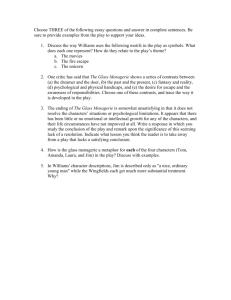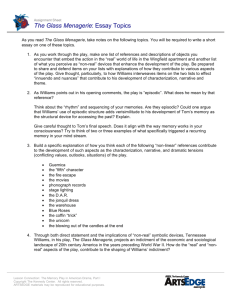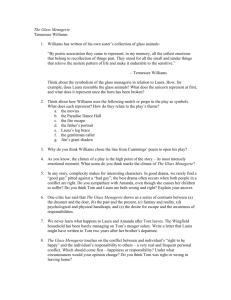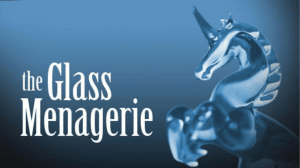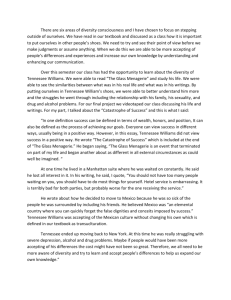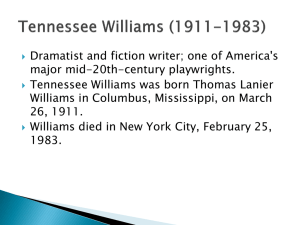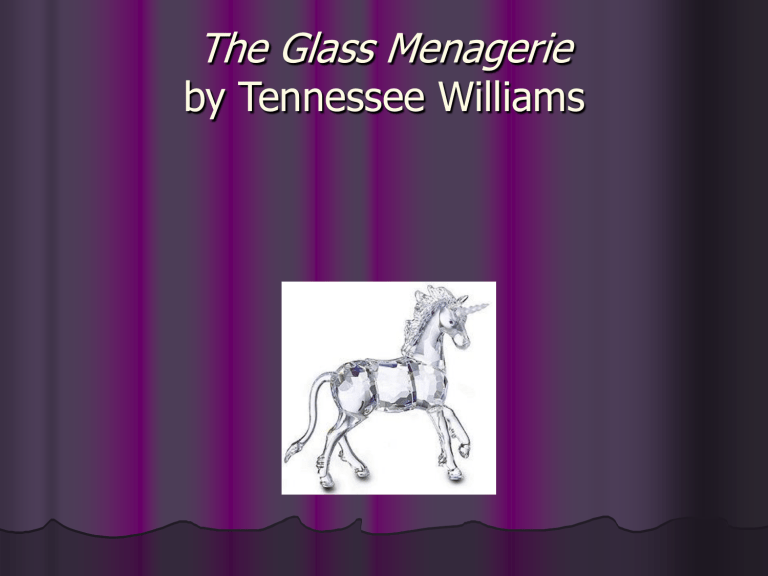
The Glass Menagerie by Tennessee Williams Tennessee Williams (1911-1983) Thomas Lanier Williams grew up in Columbus, Mississippi. He and his older sister Rose were raised in his maternal grandparents’ home (his grandfather was an Episcopalian clergyman) in a supportive, bookish atmosphere. When his father, an extroverted traveling shoe salesman, took a desk job in St. Louis, the family was uprooted from its sheltered, genteel existence and transplanted to a cheerless, backstreet apartment. Looking back on the traumatic move (an expulsion from a Southern Eden that became a motif in his plays), Williams observed, “We suddenly discovered that there were two kinds of people, the rich and the poor, and we belonged more to the latter.” Williams’ college education was interrupted during the depression, when he worked for three years in a shoe factory—a job he detested. He resumed his studies and in 1938 received a degree from the University of Iowa. The next few years were lean ones in which he variously wrote, waited on tables, and worked on a pigeon ranch. The Glass Menagerie opened on Broadway in 1945 and established Williams as a major dramatic talent. The play introduced several motifs that run throughout the works: the vulnerable and anguished woman who lives in a fragile fantasy world; the family hobbled by emotional or physical poverty; the domineering and manipulative parent; and the haunting sense of the old South as a romantic bygone era. In the next eighteen years, he wrote over a dozen plays, including A Streetcar Named Desire, Summer and Smoke, The Rose Tattoo, Cat on a Hot Tin Roof, and Suddenly Last Summer. Along with Eugene O’Neill and Arthur Miller, Williams is considered among the greatest of American playwrights. His works have served as vehicles on stage, screen and TV for Marlon Brando, Elizabeth Taylor, Richard Burton, Katherine Hepburn, Paul Newman, Joanne Woodward, and John Malkovich. Critic Kenneth Tynan observed of Williams’ works, “In his mental battlefield the real is perpetually at war with the ideal; what is public wrestles with what is private; what drags men down fights with what draws them up.” Williams’ focus on the conflict between good and evil, flesh and spirit, links him to nineteenthcentury moral symbolists—Poe, Hawthorne, and Melville. Yet it is not these epic battles but the human beings who fight them that we find memorable in the works of Williams—the outcasts, the odd, the lonely, and the vulnerable—who despite their flaws achieve a kind of dignity in their struggle to survive. The Memory Play: Tennessee Williams claimed that all his major plays fit into the “memory play” format he described in the production notes for this play. The memory play is a three-part structure: 1. A character experiences something profound. 2. That experience causes what Williams terms “an arrest of time,” a situation in which time literally loops upon itself. 3. The character must relive that profound experience (in that loop of time) until he or she makes sense of it. Although plays conventionally do not have narrators, in this memory play Tom functions as both first-person narrator and participant. In addition to this unusual point of view, Williams also makes use of another technique usually more present in narration than in drama: flashback. To signal the flashbacks Williams uses the simple devices of Tom’s clothing and the dramatic monologue. When he is wearing the seaman’s coat and hat, Tom is speaking in the present. This dramatic convention is used consistently throughout the play. American Dream/Nightmare: This concept focuses on the unattainable American Dream due to socio-economic circumstances. Dreams of wealth, success, and happiness are crushed by the grim realities of the lower class existence. In this play, the American Dream, suggested by the gauze curtains and romantic lighting, and its counterpart, the American Nightmare, grounded in the claustrophobic tenement, are pitted as foils. The young narrator’s dreams, the mother’s attempts to recapture the graceful decorum of the old South, the daughter’s fragile fantasies, even the gentleman caller’s rosy optimism, cannot remain in tact in this shabby, urban setting. Stage Directions: Stage directions function as exposition or description. At the beginning of the play, stage directions establish both the setting and the mood by describing the grim tenement, flanked by garbage cans, alleys, & fire escapes. The stage directions introduce major props and develop characterization. They also convey important clues to the reader about how you should regard a scene. Dialogue: Dialogue functions to advance the action in a play. Tom as the narrator remains more aloof and philosophical that Tom as a character. Amanda lapses into Southern coquetry in the presence of the gentleman caller. Comparisons and Contrasts Among Settings, Characters, and Scenes: Representing the twin worlds of fact and dream, the claustrophobic tenement serves as a foil to both the fragile world of glass animals and the romantic Deep South of Amanda’s past. Themes: The overarching theme for his plays, Williams claimed, is the negative impact that conventional society has upon the “sensitive non-conformist individual,” with an emphasis on the irrational and the desperation of humanity. Elements of Modernism in Williams’ Technique: New, plastic theatre vs. theatre of realistic conventions Fluidity of consciousness Unconventional techniques & freedom of convention Emphasis on the divided self: mask vs. inner self Narrative approach: point of view & flashback Music: Used to evoke mood and haunt memory Reinforces the symbolism in the play Williams describes the recurring theme of music as light, delicate, sad, and fragile He adds that it is primarily Laura’s music and it emerges more clearly when the play focuses on her Lighting: Dim and poetic, the lighting, along with the gauze curtains, lends an unreal aura to the set, suggesting that the family functions in a world of dreams Lighting gives truth the “pleasant disguise of illusion” Laura’s lighting is distinct Spotlights appear on the photograph and the fire escape The candelabrum is another symbolic Expressionism: An art movement in the late 19th and early 20th century advocating that art should be a direct expression of the inner feelings of heightened emotions of an individual through distortion or exaggerated obtrusion into the “outside” reality rather than building art that tries to objectively recreate the external “real” Color in The Glass Menagerie: Blue is associated with Laura Jim’s nickname for Laura—Blue Roses— suggests a phenomenon that is contrary to nature Yellow is associated with Amanda (her yellow dress and the jonquils) The color yellow comes to suggest Amanda’s outgoing and optimistic attitude, just as blue connotes the melancholy outlook of Laura Historical Context for the Play: The Glass Menagerie takes place In 1937: Political Climate: Franklin D. Roosevelt is the president of the U.S. Neville Chamberlain becomes the British Prime Minister. Japan invades the China (the attack that some would mark as the beginning of World War II). At Francisco Franco’s request, Adolph Hitler bombs Guernica. Social Climate: Movies were popular. By 1930, 90, 000, 000 people attended movies weekly. Billie Holiday gains popularity for her “cool” jazz. Frank Lloyd Wright’s architecture gets noticed. Worker’s unions are on the rise. New York Yankees win the World Series. Howard Johnson starts the trend of franchised restaurants. FDR states, “I see one third of a nation ill-housed, illclad, ill-nourished.” Business activity suffers a sharp drop. The Miller-Tyding’s Act allows manufacturers to fix the resale prices of brand name merchandise. Religious Climate: “I never knew that the Lord rented space…These Northern Episcopalians! I can understand the Southern Episcopalians, but these Northern ones, no.” (Amanda Wingfield, Act I scene 1). The practice of some Episcopalian churches of labeling the pews with the names of church members was unfamiliar to--and unwanted by--Amanda. The practice was popular, however, and ensured families the same seat every Sunday. At the start of the 20th century, the U.S. census listed 700,000 as Episcopalian; by the mid-30s, the Episcopalian religion was introduced in many towns by people like Tennessee Williams’ grandfather, an Episcopalian minister, and was spreading throughout the United States. New in 1937: Supermarket shopping carts Drive-in banking Spam (the edible kind—not the irritating emails!) U.S. blood bank Antihistamines Golden Gate Bridge Nylon is patented Closing Thoughts: “It is no mere coincidence that many of our most memorable American plays…depict familial tensions and alienations, the give-and-take of domestic warfare. Indeed, the venerable tradition of dramatizing family strife is by no means uniquely American, as this motif transcends cultures and predates Shakespeare’s Hamlet, even going back to the drama of Aeschylus. Tennessee Williams certainly realized that positioning crises of the heart within the immediate family would provide ample material for audience empathy and catharsis, as virtually anyone can identify with similar levels of emotional conflict.” “…Menagerie reveals the story of family members whose lives form a triangle of quiet desperation, each struggling with an individual version of hell, while simultaneously seeking an escape from the gravity of each other’s pathologies.” “Williams once described Menagerie as ‘my first quiet play, and perhaps my last.’ From this quietness, however, his characters’ cries of desperation will continue to reach out for understanding as long as we are there to listen.” (Passages taken from Robert Bray’s introduction to the play) Sources: The United States in Literature: America Reads: Classic Edition. James E. Miller, Jr., Kerry M. Wood, and Carlota Cardenas de Dwyer, Eds. Sunnyvale, California: Scott, Foresman and Company, 1991. The Glass Menagerie. Perfection Learning Company, 1994. The Glass Menagerie. Contemporary Classics, 1977. The Glass Menagerie, by Tennessee Williams. New Directions version, 1999. Images courtesy of Google.com
